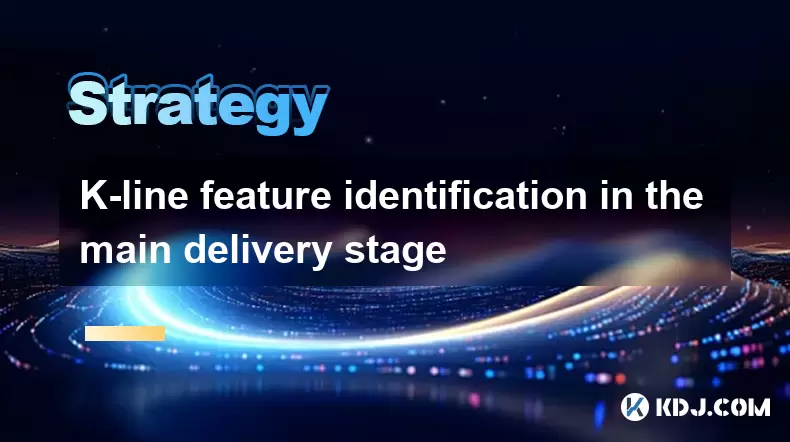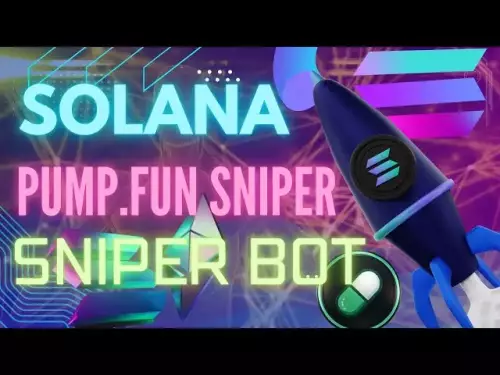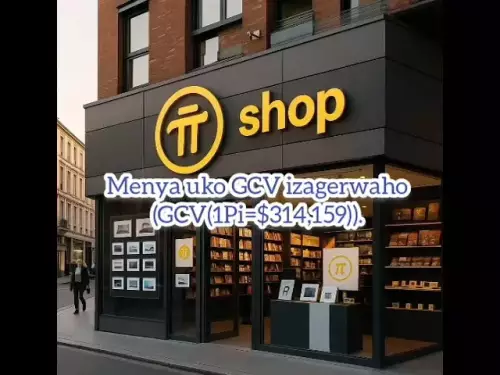-
 bitcoin
bitcoin $112195.049338 USD
2.42% -
 ethereum
ethereum $4124.915858 USD
2.81% -
 tether
tether $1.000570 USD
0.02% -
 xrp
xrp $2.861568 USD
2.25% -
 bnb
bnb $1000.346670 USD
3.04% -
 solana
solana $209.070819 USD
3.38% -
 usd-coin
usd-coin $0.999870 USD
0.02% -
 dogecoin
dogecoin $0.235379 USD
2.65% -
 tron
tron $0.335681 USD
-0.20% -
 cardano
cardano $0.803501 USD
3.38% -
 hyperliquid
hyperliquid $47.120881 USD
3.56% -
 chainlink
chainlink $21.501300 USD
3.44% -
 ethena-usde
ethena-usde $1.000571 USD
0.02% -
 avalanche
avalanche $29.793378 USD
3.62% -
 stellar
stellar $0.366964 USD
2.42%
K-line feature identification in the main delivery stage
K-line charts are vital for crypto traders, especially during the main delivery stage, where patterns like Doji and engulfing signals help predict price movements.
Jun 04, 2025 at 09:56 pm

K-line charts are fundamental tools for traders in the cryptocurrency market, providing insights into price movements and potential future trends. In the main delivery stage, the identification of specific K-line features becomes crucial for making informed trading decisions. This stage is typically characterized by increased trading volume and volatility, making it essential for traders to accurately interpret K-line patterns to capitalize on potential opportunities.
Understanding the Main Delivery Stage
The main delivery stage in cryptocurrency trading refers to the period when a significant amount of the asset is expected to be delivered or settled. This stage often coincides with the expiration of futures contracts or other derivative instruments, leading to heightened market activity. During this time, traders need to be particularly vigilant in identifying K-line features that can signal upcoming price movements.
Key K-line Features in the Main Delivery Stage
Several K-line features are particularly relevant during the main delivery stage. These include:
- Doji: A Doji represents a situation where the opening and closing prices are virtually the same, indicating market indecision. In the main delivery stage, a Doji can suggest that the market is poised for a significant move in either direction.
- Hammer and Hanging Man: These patterns are characterized by a small body and a long lower shadow. A Hammer at the bottom of a downtrend can signal a potential bullish reversal, while a Hanging Man at the top of an uptrend may indicate a bearish reversal.
- Engulfing Patterns: An engulfing pattern occurs when a candle completely engulfs the body of the previous candle. A bullish engulfing pattern can suggest a reversal from a downtrend, while a bearish engulfing pattern can indicate a reversal from an uptrend.
- Shooting Star and Inverted Hammer: These patterns have a small body and a long upper shadow. A Shooting Star at the top of an uptrend can signal a potential bearish reversal, while an Inverted Hammer at the bottom of a downtrend may indicate a bullish reversal.
Identifying Doji Patterns
Identifying a Doji during the main delivery stage involves the following steps:
- Observe the Candle: Look for a candle where the opening and closing prices are very close or identical.
- Check the Context: A Doji is more significant if it appears after a strong trend. For example, a Doji after a prolonged uptrend could suggest that the bulls are losing momentum.
- Analyze Volume: High trading volume accompanying a Doji can reinforce its significance, indicating strong market interest at the current price level.
Recognizing Hammer and Hanging Man Patterns
To identify Hammer and Hanging Man patterns in the main delivery stage, follow these steps:
- Examine the Body and Shadow: Look for a small body and a long lower shadow. The upper shadow should be minimal or non-existent.
- Assess the Trend: A Hammer is more significant at the end of a downtrend, while a Hanging Man is more significant at the end of an uptrend.
- Confirm with Volume: Increased volume can confirm the validity of these patterns, suggesting a potential reversal.
Spotting Engulfing Patterns
Identifying engulfing patterns during the main delivery stage involves the following steps:
- Identify the Previous Candle: Look at the previous candle and note its body size and direction.
- Analyze the Current Candle: The current candle should completely engulf the body of the previous candle. A bullish engulfing pattern has a larger bullish candle following a smaller bearish candle, while a bearish engulfing pattern has a larger bearish candle following a smaller bullish candle.
- Evaluate the Context: Engulfing patterns are more significant when they occur at key support or resistance levels.
Detecting Shooting Star and Inverted Hammer Patterns
To recognize Shooting Star and Inverted Hammer patterns during the main delivery stage, follow these steps:
- Examine the Body and Shadow: Look for a small body and a long upper shadow. The lower shadow should be minimal or non-existent.
- Assess the Trend: A Shooting Star is more significant at the end of an uptrend, while an Inverted Hammer is more significant at the end of a downtrend.
- Confirm with Volume: High volume accompanying these patterns can reinforce their significance, indicating a potential reversal.
Practical Application of K-line Features
In the main delivery stage, traders can apply the identified K-line features to make informed trading decisions. For instance, if a bullish engulfing pattern is spotted at a key support level with high volume, a trader might consider entering a long position. Conversely, if a Shooting Star appears at a resistance level with significant volume, a trader might consider shorting the asset.
Frequently Asked Questions
Q1: How does the main delivery stage affect K-line patterns?The main delivery stage can amplify the significance of K-line patterns due to increased trading volume and volatility. Patterns that might be less significant in quieter market conditions can become crucial indicators of potential price movements during this stage.
Q2: Can K-line patterns alone be used for trading decisions during the main delivery stage?While K-line patterns provide valuable insights, they should not be used in isolation. Traders should combine K-line analysis with other technical indicators, such as moving averages and RSI, as well as fundamental analysis to make well-rounded trading decisions.
Q3: How can traders prepare for the main delivery stage?Traders can prepare for the main delivery stage by closely monitoring K-line patterns in the lead-up to the event, setting up alerts for key price levels, and maintaining a flexible trading strategy to adapt to the increased volatility and potential price swings.
Q4: Are there specific cryptocurrencies that are more affected by the main delivery stage?Cryptocurrencies with active futures markets, such as Bitcoin and Ethereum, are typically more affected by the main delivery stage. However, the impact can vary depending on the overall market conditions and the specific derivative instruments involved.
Disclaimer:info@kdj.com
The information provided is not trading advice. kdj.com does not assume any responsibility for any investments made based on the information provided in this article. Cryptocurrencies are highly volatile and it is highly recommended that you invest with caution after thorough research!
If you believe that the content used on this website infringes your copyright, please contact us immediately (info@kdj.com) and we will delete it promptly.
- Mutuum Finance Presale Defies Market Volatility: A New Era for DeFi?
- 2025-09-30 00:45:13
- Floki Crypto: Analyst Signals Potential Pump Setup – Ready to Ride the Wave?
- 2025-09-30 00:45:13
- Hypurr Hysteria: NFTs, Floor Prices, and Hyperliquid's Wild Ride
- 2025-09-30 01:45:13
- Remittix: The Crypto World's Next XRP?
- 2025-09-30 00:50:01
- Whales, MAGACOIN, and Presale ROI: Riding the Crypto Wave
- 2025-09-30 00:50:01
- ChatGPT, Crypto Market, and Hidden Gems: Unearthing Opportunities in the Digital Gold Rush
- 2025-09-30 01:05:14
Related knowledge

Practical parameter settings for a Bitcoin multi-timeframe moving average system
Sep 18,2025 at 10:54pm
Optimizing Timeframe Combinations for Bitcoin Trading1. Selecting appropriate timeframes is crucial when building a multi-timeframe moving average sys...

How can I filter out false breakouts in Dogecoin high-frequency trading?
Sep 22,2025 at 01:00am
Understanding False Breakouts in Dogecoin Trading1. A false breakout occurs when Dogecoin's price appears to move beyond a defined support or resistan...

Techniques for identifying tops and bottoms in the Bitcoin on-chain NVT model
Sep 20,2025 at 07:54pm
Understanding the NVT Model in Bitcoin Analysis1. The Network Value to Transactions (NVT) ratio is often described as the 'P/E ratio' of the cryptocur...

What does the surge in open interest in Bitcoincoin futures mean?
Sep 20,2025 at 11:18pm
Understanding the Surge in Dogecoin Futures Open Interest1. A surge in open interest within Dogecoin futures indicates a growing number of active cont...

How can I use the Ethereum USDT premium to gauge market sentiment?
Sep 18,2025 at 11:55pm
Understanding the Ethereum USDT Premium1. The Ethereum USDT premium refers to the price difference between USDT (Tether) traded on Ethereum-based plat...

What should I do if Ethereum staking yields decline?
Sep 20,2025 at 06:18am
Understanding the Causes Behind Declining Ethereum Staking Yields1. The Ethereum network transitioned to a proof-of-stake consensus mechanism with the...

Practical parameter settings for a Bitcoin multi-timeframe moving average system
Sep 18,2025 at 10:54pm
Optimizing Timeframe Combinations for Bitcoin Trading1. Selecting appropriate timeframes is crucial when building a multi-timeframe moving average sys...

How can I filter out false breakouts in Dogecoin high-frequency trading?
Sep 22,2025 at 01:00am
Understanding False Breakouts in Dogecoin Trading1. A false breakout occurs when Dogecoin's price appears to move beyond a defined support or resistan...

Techniques for identifying tops and bottoms in the Bitcoin on-chain NVT model
Sep 20,2025 at 07:54pm
Understanding the NVT Model in Bitcoin Analysis1. The Network Value to Transactions (NVT) ratio is often described as the 'P/E ratio' of the cryptocur...

What does the surge in open interest in Bitcoincoin futures mean?
Sep 20,2025 at 11:18pm
Understanding the Surge in Dogecoin Futures Open Interest1. A surge in open interest within Dogecoin futures indicates a growing number of active cont...

How can I use the Ethereum USDT premium to gauge market sentiment?
Sep 18,2025 at 11:55pm
Understanding the Ethereum USDT Premium1. The Ethereum USDT premium refers to the price difference between USDT (Tether) traded on Ethereum-based plat...

What should I do if Ethereum staking yields decline?
Sep 20,2025 at 06:18am
Understanding the Causes Behind Declining Ethereum Staking Yields1. The Ethereum network transitioned to a proof-of-stake consensus mechanism with the...
See all articles


























![[Pycoin] PI Coin -Shocking Listance of Pycoin?! 'Rebellion' This time ... Pay attention to #paikoin [Pycoin] PI Coin -Shocking Listance of Pycoin?! 'Rebellion' This time ... Pay attention to #paikoin](/uploads/2025/09/29/cryptocurrencies-news/videos/pycoin-pi-coin-shocking-listance-pycoin-rebellion-time-pay-attention-paikoin/68da82f23cec1_image_500_375.webp)















































